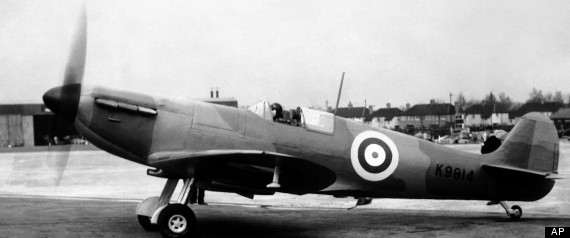
YANGON, Myanmar — As many as 140 World War II Spitfire fighter planes – three to four times the number of airworthy models known to exist – are believed to be buried in near-pristine condition in Myanmar. A British-Myanmar partnership says it will begin digging them up by the end of the month.
The go-ahead for excavation came earlier this week when the Myanmar government signed an agreement with British aviation enthusiast David J. Cundall and his local partner. Cundall, a farmer and businessman, earlier this year announced he had located 20 of the planes, best known for helping the Royal Air Force win mastery of the skies during the Battle of Britain.
On Thursday, however, a retired Myanmar geology professor who has assisted in the recovery operation since 1999 said there are about 140 Spitfires buried in various places around the Southeast Asian country, which until 1948 was a British colony called Burma. He did not explain the discrepancy in estimates.
Soe Thein said the British brought crates of Spitfires to Myanmar in the closing stages of the war, but never used them when the Japanese gave up the fight in 1945. The single-seat version of the fighter plane was 9.14 meters (30 feet) long with an 11.3 meter (37 foot) wingspan.
The U.S. Army was in charge of burying the planes after British forces decided to dispose of them that way, he said, adding Cundall interviewed at least 1,000 war veterans, mostly American, to gather information about the aircraft's fate.
He said a ground search was started in 1999 using magnetometers and ground radar, but faced difficulties. Only in recent years did technology become advanced enough to be more certain of the finds, he said.
Each plane was kept in a crate about 12.2 meters (40 feet) long, 3.4 meters (11 feet) high and 2.7 meters (9 feet) wide, said Soe Thein.
The plans under a two-year contract are to recover 60 planes in the first phase: 36 planes in Mingaladon, near Yangon's current air base and international airport; 18 in Myitkyina in Kachin state in the north; and six in Meikthila in central Myanmar. Others are to be recovered in a second phase.
The Myanmar government will get one plane for display at a museum, as well as half of the remaining total. DJC, a private company headed by Cundall, will get 30 percent of the total and the Myanmar partner company, Shwe Taung Paw, 20 percent.
British Prime Minister David Cameron eased the way to an agreement when he visited Myanmar President Thein Sein in April.
Cundall has said his quest to find the planes involved 12 trips to Myanmar and cost more than 130,000 pounds ($210,000), not including the planned excavation expenses.
Spitfires in working shape are rare and popular with collectors. In 2009, a restored but airworthy Spitfire was sold by British auction house Bonhams for >1,739,500 ($2,544,130)
The excavation agreement was signed Tuesday by Civil Aviation Director-General Tin Naing Tun, Cundall on behalf of DJC, and Htoo Htoo Zaw, managing director of Shwe Taung Paw.
"It took 16 years for Mr. David Cundall to locate the planes buried in crates. We estimate that there are at least 60 Spitfires buried and they are in good condition," Htoo Htoo Zaw said Wednesday. "We want to let people see these historic fighters, and the excavation of these fighter planes will further strengthen relations between Myanmar and Britain."
The British Embassy on Wednesday described the agreement as a chance to work with Myanmar's new reformist government to restore and display the planes.
"We hope that many of them will be gracing the skies of Britain and as discussed, some will be displayed here in Burma," said an embassy spokesman, who spoke anonymously because he was not directly involved in the excavation agreement.
Myanmar from 1962 until last year was under the rule of the military, which changed the country's name from Burma in 1989. Thein Sein's reformist government has turned away from the repression of the military government and patched up relations with Western nations that had previously shunned it.
The state-owned Myanma Ahlin daily on Wednesday cited Transport Minister Nyan Tun Aung as saying the Spitfire agreement amounts to the British government's recognition of the democratic reforms.

No comments:
Post a Comment